Cards: Action Packed 1991, Action Packed Rookies 1992, Pro Set 1991 Heisman Heroes, Score 1989, Score 1990 Ground Force
Acquired: In Person 1994, 1997, Philadelphia Eagles Training Camp, Dallas Cowboys Training Camp. TTM, 2011. C/o Home
Sent: 1/13/11 Received: 7/5/11 (173 days)
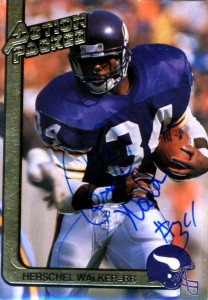 Herschel Walker? In my estimates of some of the great runningbacks in football, I would say I was enthralled by Herschel Walker. I knew who Herschel was before I even watched football. A record breaking machine for the Georgia Bulldogs in college, Walker would be a 3 time All American and win the Heisman in 1982. Herschel was a shrewd businessman, and realized that with the advent of the upstart USFL he could effectively carve his own destiny and make more money off of endorsements. Plus without rules regarding underclassmen, Herschel could declare for the USFL draft as a Junior- something he couldn’t do in the NFL. With that being said, Walker would be drafted by the New Jersey Generals of the USFL in 1983. He’d go on to crush opposing defenses winning the rushing title in both 1983 and 1985 before the league dissolved. In the meantime however, the Dallas Cowboys waited, dropping a 5th round choice on Walker suspecting it would just be a matter of time.
Herschel Walker? In my estimates of some of the great runningbacks in football, I would say I was enthralled by Herschel Walker. I knew who Herschel was before I even watched football. A record breaking machine for the Georgia Bulldogs in college, Walker would be a 3 time All American and win the Heisman in 1982. Herschel was a shrewd businessman, and realized that with the advent of the upstart USFL he could effectively carve his own destiny and make more money off of endorsements. Plus without rules regarding underclassmen, Herschel could declare for the USFL draft as a Junior- something he couldn’t do in the NFL. With that being said, Walker would be drafted by the New Jersey Generals of the USFL in 1983. He’d go on to crush opposing defenses winning the rushing title in both 1983 and 1985 before the league dissolved. In the meantime however, the Dallas Cowboys waited, dropping a 5th round choice on Walker suspecting it would just be a matter of time.
Herschel would join the Cowboys in 1987, and go onto etch his name into the Cowboys faithful minds for years to come not only for his incredible play of which he’d earn ProBowl berths in 1987 and 1988 – but for what would later come to be known as “The Trade”.
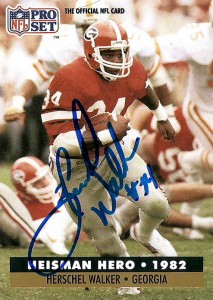 The Minnesota Vikings believed they needed one more piece in order to get to the SuperBowl, and in 1989 the Cowboys were looking to rebound from a 3-13 season. Jimmy Johnson and Jerry Jones found the offer from the Vikings too good to pass up. Without going into details the final totals were astounding. The Vikings would trade the Cowboys 5 players, and 8 draft choices – including 3 first round choices over the next 3 years. Minnesota in return got Walker, 2 3rd round choices, a 5 round choice and a 10th round choice. The implications were far reaching and would set the foundation for the Cowboys championship runs. Looking back in retrospect, it’s hard not to see that Herschel took the trade hard. In the end he was treated as a commodity and his Viking tenure was filled with pressure as being the hailed savior of the franchise.
The Minnesota Vikings believed they needed one more piece in order to get to the SuperBowl, and in 1989 the Cowboys were looking to rebound from a 3-13 season. Jimmy Johnson and Jerry Jones found the offer from the Vikings too good to pass up. Without going into details the final totals were astounding. The Vikings would trade the Cowboys 5 players, and 8 draft choices – including 3 first round choices over the next 3 years. Minnesota in return got Walker, 2 3rd round choices, a 5 round choice and a 10th round choice. The implications were far reaching and would set the foundation for the Cowboys championship runs. Looking back in retrospect, it’s hard not to see that Herschel took the trade hard. In the end he was treated as a commodity and his Viking tenure was filled with pressure as being the hailed savior of the franchise.
Walker had just come off a 1500 + yard season rushing for the Cowboys and the Vikings were struggling on the ground. Inexplicably the Vikings really couldn’t figure out the right way to use Herschel even though he was utilized on kick returns and also as a running back, – he became the butt of jokes in Minnesota. After a failed suicide attempt (by carbon monoxide poisoning) the writing was on the wall for the franchise, and by 1992 the Vikings cut Walker.
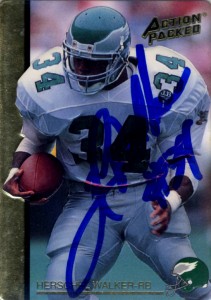 Immediately the Eagles came calling with fans hailing Walker as their savior. Walker would not disappoint rushing for over a 1000 yards for the Eagles and posting another 200 plus yards receiving in 1992- his best rushing effort since leaving Dallas. Walker would stay with Philadelphia another 2 years afterwards where I’d get his autograph in West Chester at Eagles training camp that year.
Immediately the Eagles came calling with fans hailing Walker as their savior. Walker would not disappoint rushing for over a 1000 yards for the Eagles and posting another 200 plus yards receiving in 1992- his best rushing effort since leaving Dallas. Walker would stay with Philadelphia another 2 years afterwards where I’d get his autograph in West Chester at Eagles training camp that year.
Walker would sign in 1995 with the Giants as a free agent and play one non-descrpit season there before returning home to the Cowboys in 1996. The Cowboys would put him to use as a fullback his final two seasons, where I’d get his autograph in 1997 at Berger stadium (next to Michael Irvin), before he retired.
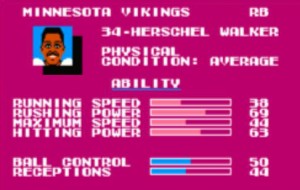 One wonders how Herschel would have been remembered if he did not go to the USFL or if Michael Irvin was traded to the Los Angeles Raiders instead (as was originally rumored). Combining his numbers from his years in the USFL with his NFL numbers, Walker ranks 5th all time on the rushing list. Herschel also holds the all time record for rushing yards in a football season with 2411 yards. In 1999 he was inducted into the College Football HoF, is widely regarded as the best runningback in the history of college football, had his number retired at Georgia and wrote an autobiography. One of my favorite athletes, (-and easily my favorite Cowboy,) I even owned Herschel’s Starting Lineup figurine. If you played the original Tecmo Bowl, all you could do with the Cowboys is run with Herschel, and that gave you a leg up on the puny Colts. The 1991 offering of Tecmo Super Bowl endeared him to us as a member of the Minnesota Vikings. Despite his popularity Walker has remained a stalwart TTM signer, and I got his autographs on the Pro Set 1991 Heisman Heroes, Score 1990 Ground Force, and Score 1989 cards in 173 days.
One wonders how Herschel would have been remembered if he did not go to the USFL or if Michael Irvin was traded to the Los Angeles Raiders instead (as was originally rumored). Combining his numbers from his years in the USFL with his NFL numbers, Walker ranks 5th all time on the rushing list. Herschel also holds the all time record for rushing yards in a football season with 2411 yards. In 1999 he was inducted into the College Football HoF, is widely regarded as the best runningback in the history of college football, had his number retired at Georgia and wrote an autobiography. One of my favorite athletes, (-and easily my favorite Cowboy,) I even owned Herschel’s Starting Lineup figurine. If you played the original Tecmo Bowl, all you could do with the Cowboys is run with Herschel, and that gave you a leg up on the puny Colts. The 1991 offering of Tecmo Super Bowl endeared him to us as a member of the Minnesota Vikings. Despite his popularity Walker has remained a stalwart TTM signer, and I got his autographs on the Pro Set 1991 Heisman Heroes, Score 1990 Ground Force, and Score 1989 cards in 173 days.
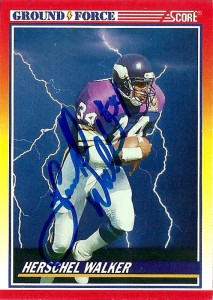 Herschel at the time of his retirement minus his USFL numbers, was ranked 3rd in total yards from scrimmage with 18,168 combined yards rushing, receiving, and kick returning. Including his USFL numbers, Walker would hold the combined yards from scrimmage number with an additional 7,115 yards. He is also one of a select few players to have a touchdown rushing, receiving and kick returning, all of over 90 yards.
Herschel at the time of his retirement minus his USFL numbers, was ranked 3rd in total yards from scrimmage with 18,168 combined yards rushing, receiving, and kick returning. Including his USFL numbers, Walker would hold the combined yards from scrimmage number with an additional 7,115 yards. He is also one of a select few players to have a touchdown rushing, receiving and kick returning, all of over 90 yards.
Walker is a through and through athlete. He remains in peak physical shape, and has over the years participated in the Winter Olympics, is a 5th degree blackbelt, and recently taken up mixed martial arts winning by TKO his first two matches.
NFL
G/Gs 187/138 Att 1954 Yds 8225 Avg 4.2 Td 61 Lg 91 |
Rec 512 Yds 4859 Avg 9.5 Td 21 Lg 93 |
Kr 215 Yds 5084 Avg 23.6 Td 2 Lg 94
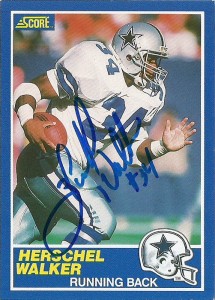
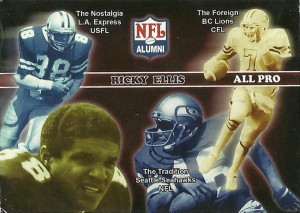
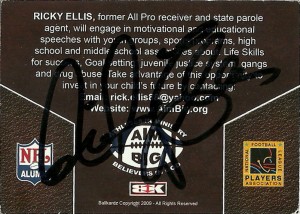 Card: BK 2009
Card: BK 2009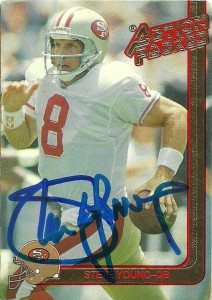 From what I understand, Steve Young has been rumored to be an ‘autopenner’. Autopenning is a relatively new and ruthless thing that players can do to fans hoping for an authentic autograph from them. An autopen is a machine that will line up the card and simulate the player’s signature. While I’m not sure what to think of this, many fans decry it because it lessens the interaction between the fan and the player and thus- it is not authentic. I could see how this would anger somebody who had his rookie card and really wanted him to sign it but for these two cards, it wouldn’t really bother me either way.
From what I understand, Steve Young has been rumored to be an ‘autopenner’. Autopenning is a relatively new and ruthless thing that players can do to fans hoping for an authentic autograph from them. An autopen is a machine that will line up the card and simulate the player’s signature. While I’m not sure what to think of this, many fans decry it because it lessens the interaction between the fan and the player and thus- it is not authentic. I could see how this would anger somebody who had his rookie card and really wanted him to sign it but for these two cards, it wouldn’t really bother me either way.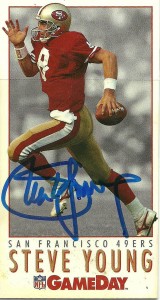 Steve Young is another player who just got no respect- but in his case, he went out and proved them all wrong. As you can tell from these two cards, Steve Young is doing what he does best- run. After graduating from BYU, Steve Young signed a then record 10 year 40 million dollar contract with the Los Angeles Express of the USFL. He’d lead the team to the playoffs his rookie season but in 1985 the league financially hemorrhaged.
Steve Young is another player who just got no respect- but in his case, he went out and proved them all wrong. As you can tell from these two cards, Steve Young is doing what he does best- run. After graduating from BYU, Steve Young signed a then record 10 year 40 million dollar contract with the Los Angeles Express of the USFL. He’d lead the team to the playoffs his rookie season but in 1985 the league financially hemorrhaged.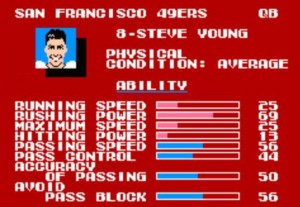 Steve’s rebirth would begin in San Fransisco as future HoFer Joe Montana’s backup. He’d become the league’s best insurance premium, tutored by coaching wiz Bill Walsh and his offensive staff. As Young would bide his time, Montana’s age and frailty would emerge, and at some points a quarterback controversy would emerge. In 1991 after Montana was sidelined for the season, it was largely believed that this was Young’s shot at being the team’s starter, but after injury and relative ineffectiveness- Young would be locked in a quarterback controversy with
Steve’s rebirth would begin in San Fransisco as future HoFer Joe Montana’s backup. He’d become the league’s best insurance premium, tutored by coaching wiz Bill Walsh and his offensive staff. As Young would bide his time, Montana’s age and frailty would emerge, and at some points a quarterback controversy would emerge. In 1991 after Montana was sidelined for the season, it was largely believed that this was Young’s shot at being the team’s starter, but after injury and relative ineffectiveness- Young would be locked in a quarterback controversy with